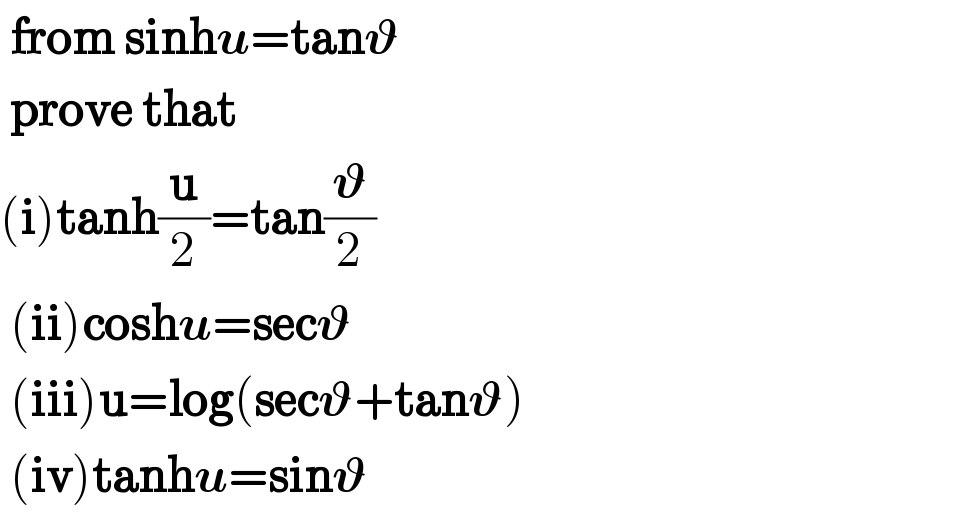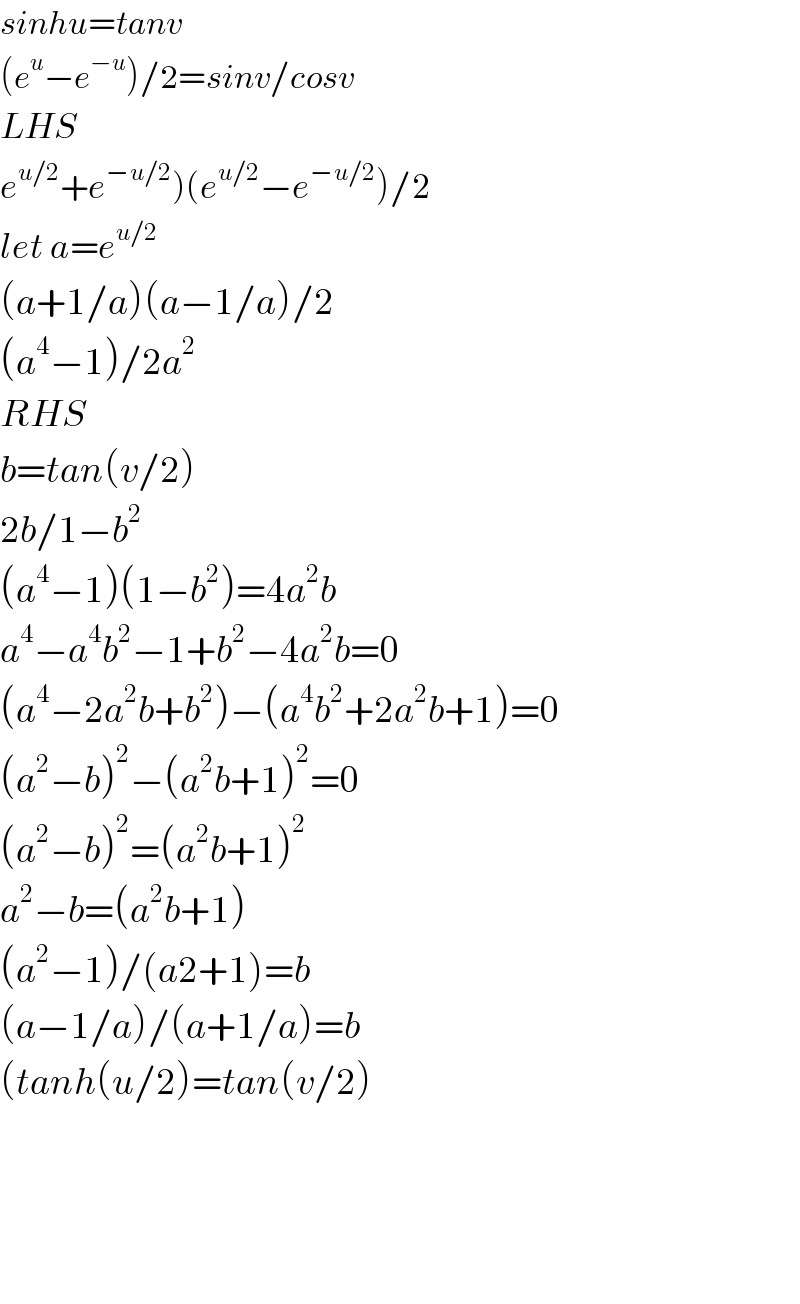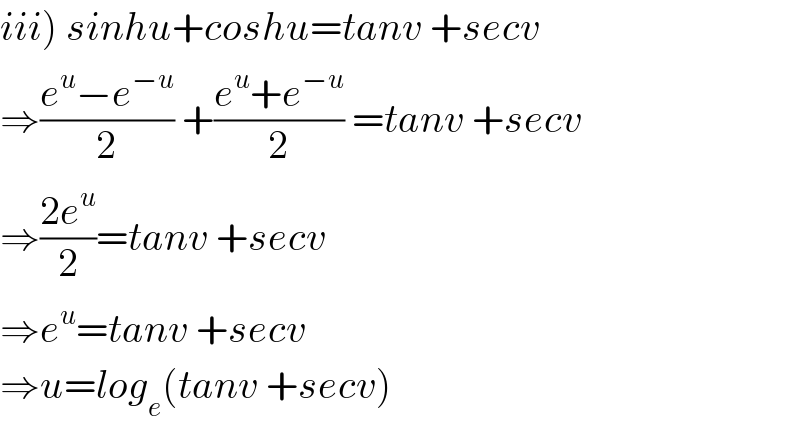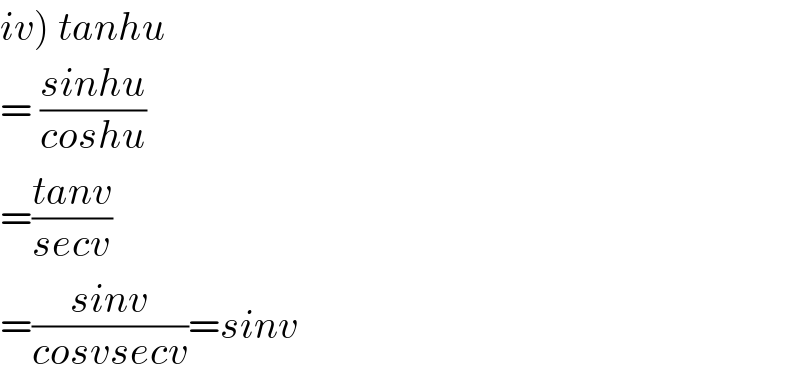Question Number 33660 by mondodotto@gmail.com last updated on 21/Apr/18

$$\:\boldsymbol{\mathrm{from}}\:\boldsymbol{\mathrm{sinh}{u}}=\boldsymbol{\mathrm{tan}\vartheta} \\ $$$$\:\boldsymbol{\mathrm{prove}}\:\boldsymbol{\mathrm{that}} \\ $$$$\left(\boldsymbol{\mathrm{i}}\right)\boldsymbol{\mathrm{tanh}}\frac{\boldsymbol{\mathrm{u}}}{\mathrm{2}}=\boldsymbol{\mathrm{tan}}\frac{\boldsymbol{\vartheta}}{\mathrm{2}} \\ $$$$\:\left(\boldsymbol{\mathrm{ii}}\right)\boldsymbol{\mathrm{cosh}{u}}=\boldsymbol{\mathrm{sec}\vartheta} \\ $$$$\:\left(\boldsymbol{\mathrm{iii}}\right)\boldsymbol{\mathrm{u}}=\boldsymbol{\mathrm{log}}\left(\boldsymbol{\mathrm{sec}\vartheta}+\boldsymbol{\mathrm{tan}\vartheta}\right) \\ $$$$\:\left(\boldsymbol{\mathrm{iv}}\right)\boldsymbol{\mathrm{tanh}{u}}=\boldsymbol{\mathrm{sin}\vartheta} \\ $$
Answered by tanmay.chaudhury50@gmail.com last updated on 21/Apr/18

$${sinhu}={tanv} \\ $$$$\left({e}^{{u}} −{e}^{−{u}} \right)/\mathrm{2}={sinv}/{cosv} \\ $$$${LHS} \\ $$$$\left.{e}^{{u}/\mathrm{2}} +{e}^{−{u}/\mathrm{2}} \right)\left({e}^{{u}/\mathrm{2}} −{e}^{−{u}/\mathrm{2}} \right)/\mathrm{2} \\ $$$${let}\:{a}={e}^{{u}/\mathrm{2}} \\ $$$$\left({a}+\mathrm{1}/{a}\right)\left({a}−\mathrm{1}/{a}\right)/\mathrm{2} \\ $$$$\left({a}^{\mathrm{4}} −\mathrm{1}\right)/\mathrm{2}{a}^{\mathrm{2}} \\ $$$${RHS} \\ $$$${b}={tan}\left({v}/\mathrm{2}\right) \\ $$$$\mathrm{2}{b}/\mathrm{1}−{b}^{\mathrm{2}} \\ $$$$\left({a}^{\mathrm{4}} −\mathrm{1}\right)\left(\mathrm{1}−{b}^{\mathrm{2}} \right)=\mathrm{4}{a}^{\mathrm{2}} {b} \\ $$$${a}^{\mathrm{4}} −{a}^{\mathrm{4}} {b}^{\mathrm{2}} −\mathrm{1}+{b}^{\mathrm{2}} −\mathrm{4}{a}^{\mathrm{2}} {b}=\mathrm{0} \\ $$$$\left({a}^{\mathrm{4}} −\mathrm{2}{a}^{\mathrm{2}} {b}+{b}^{\mathrm{2}} \right)−\left({a}^{\mathrm{4}} {b}^{\mathrm{2}} +\mathrm{2}{a}^{\mathrm{2}} {b}+\mathrm{1}\right)=\mathrm{0} \\ $$$$\left({a}^{\mathrm{2}} −{b}\right)^{\mathrm{2}} −\left({a}^{\mathrm{2}} {b}+\mathrm{1}\right)^{\mathrm{2}} =\mathrm{0} \\ $$$$\left({a}^{\mathrm{2}} −{b}\right)^{\mathrm{2}} =\left({a}^{\mathrm{2}} {b}+\mathrm{1}\right)^{\mathrm{2}} \\ $$$${a}^{\mathrm{2}} −{b}=\left({a}^{\mathrm{2}} {b}+\mathrm{1}\right) \\ $$$$\left({a}^{\mathrm{2}} −\mathrm{1}\right)/\left({a}\mathrm{2}+\mathrm{1}\right)={b} \\ $$$$\left({a}−\mathrm{1}/{a}\right)/\left({a}+\mathrm{1}/{a}\right)={b} \\ $$$$\left({tanh}\left({u}/\mathrm{2}\right)={tan}\left({v}/\mathrm{2}\right)\right. \\ $$$$ \\ $$$$ \\ $$$$ \\ $$
Commented by mondodotto@gmail.com last updated on 22/Apr/18

$$\mathrm{why}\:\boldsymbol{\mathrm{e}}^{\frac{\boldsymbol{\mathrm{u}}}{\mathrm{2}}} +\boldsymbol{\mathrm{e}}^{\frac{−\mathrm{2}}{\boldsymbol{\mathrm{u}}}} \boldsymbol{\mathrm{more}}\:\boldsymbol{\mathrm{explainations}}\:\boldsymbol{\mathrm{please}} \\ $$
Answered by math1967 last updated on 22/Apr/18
![ii) coshu=(√(1+sinh^2 u)) ⇒coshu=(√(1+tan^2 v )) [given sinhu=tanv] ∴coshu=secv](https://www.tinkutara.com/question/Q33683.png)
$$\left.{ii}\right)\:{coshu}=\sqrt{\mathrm{1}+{sinh}^{\mathrm{2}} {u}}\: \\ $$$$\Rightarrow{coshu}=\sqrt{\mathrm{1}+{tan}^{\mathrm{2}} {v}\:}\:\:\:\:\left[{given}\:\right. \\ $$$$\left.\:\:\:\:\:\:\:\:\:\:\:\:\:\:\:\:\:\:\:\:\:\:\:\:\:\:\:\:\:\:\:\:\:\:\:\:\:\:\:\:\:\:\:\:\:\:\:\:\:\:\:\:\:\:\:\:\:{sinhu}={tanv}\right] \\ $$$$\therefore{coshu}={secv} \\ $$
Answered by math1967 last updated on 22/Apr/18

$$\left.{iii}\right)\:{sinhu}+{coshu}={tanv}\:+{secv} \\ $$$$\Rightarrow\frac{{e}^{{u}} −{e}^{−{u}} }{\mathrm{2}}\:+\frac{{e}^{{u}} +{e}^{−{u}} }{\mathrm{2}}\:={tanv}\:+{secv} \\ $$$$\Rightarrow\frac{\mathrm{2}{e}^{{u}} }{\mathrm{2}}={tanv}\:+{secv} \\ $$$$\Rightarrow{e}^{{u}} ={tanv}\:+{secv} \\ $$$$\Rightarrow{u}={log}_{{e}} \left({tanv}\:+{secv}\right) \\ $$
Answered by math1967 last updated on 22/Apr/18

$$\left.{iv}\right)\:{tanhu} \\ $$$$=\:\frac{{sinhu}}{{coshu}}\: \\ $$$$=\frac{{tanv}}{{secv}} \\ $$$$=\frac{{sinv}}{{cosvsecv}}={sinv} \\ $$
